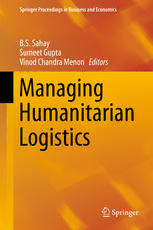
Managing Humanitarian Logistics PDF
Preview Managing Humanitarian Logistics
Springer Proceedings in Business and Economics B.S. Sahay Sumeet Gupta Vinod Chandra Menon Editors Managing Humanitarian Logistics Springer Proceedings in Business and Economics More information about this series at http://www.springer.com/series/11960 B.S. Sahay (cid:129) Sumeet Gupta (cid:129) Vinod Chandra Menon Editors Managing Humanitarian Logistics Editors B.S.Sahay SumeetGupta DepartmentofOperationsandSystems DepartmentofOperationsandSystems IndianInstituteofManagementRaipur IndianInstituteofManagementRaipur Raipur,Chhattisgarh,India Raipur,Chhattisgarh,India VinodChandraMenon FormerMember,NationalDisaster ManagementAuthority NewDelhi,India ISSN2198-7246 ISSN2198-7254 (electronic) SpringerProceedingsinBusinessandEconomics ISBN978-81-322-2415-0 ISBN978-81-322-2416-7 (eBook) DOI10.1007/978-81-322-2416-7 LibraryofCongressControlNumber:2015949924 SpringerNewDelhiHeidelbergNewYorkDordrechtLondon ©SpringerIndia2016 Thisworkissubjecttocopyright.AllrightsarereservedbythePublisher,whetherthewholeorpartof the material is concerned, specifically the rights of translation, reprinting, reuse of illustrations, recitation, broadcasting, reproduction on microfilms or in any other physical way, and transmission or information storage and retrieval, electronic adaptation, computer software, or by similar or dissimilarmethodologynowknownorhereafterdeveloped. The use of general descriptive names, registered names, trademarks, service marks, etc. in this publicationdoesnotimply,evenintheabsenceofaspecificstatement,thatsuchnamesareexempt fromtherelevantprotectivelawsandregulationsandthereforefreeforgeneraluse. Thepublisher,theauthorsandtheeditorsaresafetoassumethattheadviceandinformationinthis book are believed to be true and accurate at the date of publication. Neither the publisher nor the authors or the editors give a warranty, express or implied, with respect to the material contained hereinorforanyerrorsoromissionsthatmayhavebeenmade. Printedonacid-freepaper Springer(India)Pvt.Ltd.ispartofSpringerScience+BusinessMedia(www.springer.com) To Our Parents Preface Theworldwideriseinnaturalandman-madedisastersinthelast twodecadeshas questionedtheverypreparednesstocope withthem.Althoughlessfrequent,such disasters occur with high impact and completely disrupt the daily lives of people resultinginhugelossoflivesandcapitalstotheextentofwipingouttheentirecity. Countries the world over have been developing mechanisms to deal with such disasters,butrecentdisastersrevealthattheexistingpreparednessisstillfarbelow normal.Particularly,inemergingeconomicslikeIndia,suchpreparednessishardly givenanypreference.Thekeytocopeupwithsuchdisastersislogistics,termedas Humanitarian Logistics, organized to make life-saving drugs, food products, and othernecessaryamenitiesavailabletotheaffectedpeople. This book is a compendium of selected best papers presented at ICHL 2013 (InternationalConferenceonHumanitarianLogistics),organizedbyIIMRaipuron the2ndand3rdofDecember2013.ICHL2013isthefirstconferenceorganizedin India to address the key issue of Humanitarian Logistics. This book addresses globalcallforeffectiveHumanitarianLogistics. The holistic approach to the management of Humanitarian Logistics requires addressingfourkeyareas, namely,designingandplanninghumanitarian response strategies, developing strategies for efficient Humanitarian Logistics, modeling Humanitarian Logistics, and preparedness for emergency humanitarian response. ThisbookaddressesthesekeyareasforHumanitarianLogistics. Part I discusses about the importance of design and planning in a disaster situation. With the ever-growing natural and man-made disasters reaching epic proportion, the need for nodal agencies with appropriately trained manpower, know-how, and machinery to reduce, avoid, and hedge the uncertainty is para- mount.Thus,designandplanningaretheprimaryaspectsofHumanitarianLogis- tics that deal with preparedness for emergency well in advance with various logistics designs and planning strategies. Sahay et al. (2014) discuss the inherent issues in managing Humanitarian Logistics from the perspective of design and implementation.Paperspresentedinthissectionalsodiscussaboutthebarriersand critical success factors of an efficient humanitarian supply chain. The section vii viii Preface presentstheimportanceoflogisticsindesigningahumanitariansupplychain.Ifthe logistics is poor, then all the three stages of dealing with a disaster, namely, preparedness,response,andrecovery,willsuffer.Theplanningaspectsoflogistics during natural disasters are covered in this section. Improving logistics response times is essential for improving response to a disaster situation, and this section discusseshowlogisticsresponsecapacitycanbeimprovedbycombiningitwiththe localcommercialmobilitythroughatrucksharingsolution. Part II discusses about developing strategies for improving humanitarian response. Research and preparedness for humanitarian response is not sufficient, unlessbackedupwithproperhumanitarianresponsestrategies.Apoorlydesigned humanitarianresponsewillnotworkwellevenifalltheothernecessaryingredients of humanitarian response are in place. Formulation of strategies during the pre- paredness stage is therefore essential for effective and efficient response and recovery from a disaster. Anumber of papers presented in this section emphasize the use of technology for disaster response. Particularly the use of ICT and RFID has been presented in this section for developing effective humanitarian response strategies. Several strategies have been presented in this section and include the IT-basednetworkreliefmodel;supplychainconfigurationsforidentifyingthebest configurationanddevelopingcollectivecapacityasastrategyforimprovingdisas- terresponseandrecoveryarethemajorframeworkspresentedinthissection. Part III discusses about modeling of Humanitarian Logistics from various perspectives. Humanitarian Logistics modeling includes integrative, analytical, conceptual, inter- or multidisciplinary approaches and methods of dealing with the logistics, transport and supply chain management and emergency, crisis and disasterpreparedness,andresponseandmanagement.Themodelsandapproaches form the backbone for the decision support systems in logistics operations. These various perspectives presented include a comprehensive model for finding the optimallocationofsuppliersfordesigninghumanitarianeffortsthatmitigatesand reduces the risk of a disruption in the humanitarian aid; modeling of human elements, namely, donors and frontline staff, involved in delivering humanitarian aid for efficient relief operations; modeling of supplies for effective humanitarian responseusingp-medianapproach;modelingformulti-perioddemandallocationof reliefitemsinahumanitariansupplychains;modelingofreversesupplychainsfor improvedcostbenefits,reclaimingvalueofusedproductsandprofitsinsecondary markets and indirect benefits such as gaining customer confidence and enhancing the green image of the organization, compliance of regulations, etc., that can be appropriated;andmodelingofpost-disasterHumanitarianLogisticsstructure.The sectionalsopresentsacasestudyofanexistingruralhealthcaresystemdeployedin a slum community in India for modeling of a sustainable and successful humani- tarianeffort. PartIVofthisbookdiscussesaboutthereliefsupplychainsrequiredfordisaster management from various perspectives. A relief supply chain requires trained manpower, understanding of peculiarities of disasters in difficult terrain, logistics forreliefoperations,andreverselogisticsofdisposinghumanremainsinadisaster. The studies presented in this section discuss about challenges in management of Preface ix human resources in a disaster, strategies for developing trained manpower, and simplisticmethodsoflogisticsforeffectiveandefficientdisasterresponse,dealing with disaster situations in a high altitude area and also dealing with the human bodies/remainsafterthedisaster. The collective discussions help understand managing Humanitarian Logistics fromdesign,preparedness,response,andrecoveryperspectiveapartfromusageof technology for managing the logistics involved. We hope that this book will help academiciansandresearchersindefiningtheirresearchandpractice,respectively, towards improvement of Humanitarian Logistics towards both natural and man-madedisasters. Raipur,India B.S.Sahay Raipur,India SumeetGupta NewDelhi,India N.VinodChandraMenon
